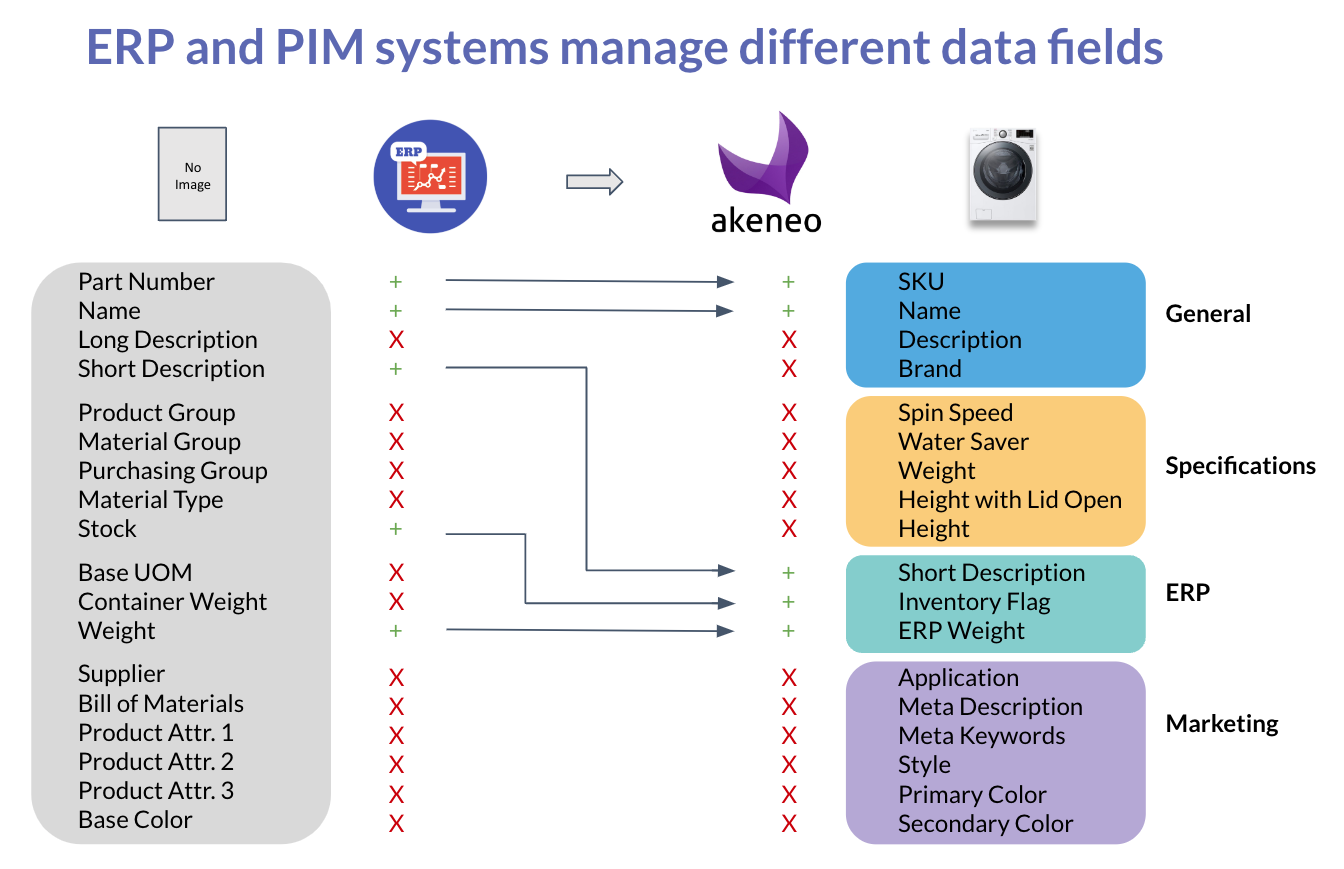Gain a better understanding of what an ERP is, how it integrates with PIM, and how it fits into the larger product ecosystem to support PXM.

Table of Contents
Keywords
And when PIM enters the mix, companies naturally want to understand the strengths and limitations of each system and how they should interact with each other. So let’s break down exactly what ERP tools are and get a better understanding of their importance to product inception and basic enrichment, their limitations in supporting customer experiences, and best practices for integrating them with PIM solutions.
Enterprise Resource Planning (ERP) is a category of business management software that centralizes, manages, and provides insights into core accounting, manufacturing, supply chain management, sales, marketing, and human resource business processes within an organization. Common characteristics of ERP solutions include a modular design with easy internal integrations, a shared database and data format, a consistent user interface, and the ability to manage real-time transactional data.
Like most software solutions today, ERP solutions are moving towards cloud-based deployments and SaaS, but many companies still use legacy on-premise solutions that in some cases can be heavily-customized. The substantial implementation costs of ERP solutions and their criticality to core business processes make ERP solutions a significant investment for most companies.
ERP solutions play an important role in Product Experience Management(PXM) for many companies because they have traditionally served as a point of origin for products and an initial collection point for basic product information. Distributors, wholesalers, and retailers originate products in their ERP systems as part of the procurement process from suppliers, while manufacturers may utilize a Product Lifecycle Management (PLM) system to develop a product before passing it onto their ERP system. In both scenarios, the ERP system is typically where the Stock Keeping Unit (SKU) is generated to identify and differentiate products across various applications in the ecosystem.
While generating SKUs within the ERP system remains the modus operandi for most companies, a recent shift has seen some businesses in industries like Fast Fashion and Home Furnishing challenge this approach. For these companies, time-to-market and customer and product experiences drive the product creation process; brand managers and marketers originate products within their Product Information Management (PIM) system before passing it onto their back-office systems (ERP).
To support this shift, many PIM vendors include capabilities for customers to generate incremental SKUs based on their unique naming conventions (Department IDs, Product Category, Supplier, etc.). It’s important to note here that regardless of where the product information originates, ERPs are still a necessary part of the ecosystem because PIM systems cannot be used to manage the rest of the vital back-office operations ERP systems perform.
ERP systems can play an important role in the creation of products in a company’s ecosystem, but they are not designed to create, manage, or distribute compelling product experiences for customers. ERP systems have rigid data models that inhibit product marketers from creating rich differentiated experiences with high levels of data governance, lack support for contextualization of product data (By Region, Language, and Sales Channel), and don’t have the ability to manage Media and Asset content.
ERP systems also lack dedicated features to support product enrichment, which relies heavily on collaboration, automation, translation, and a user-interface built for marketers.
Finally, getting data out of ERP systems can be a challenge; they don’t have syndication capabilities and store sensitive financial and customer information that brings additional security concerns that can complicate integrations with external systems.
ERP systems are important, but theyre rigid back-office systems. They arent flexible enough to meet the needs of business users managing high-quality product catalogs.'
ERP systems do house useful product data though, because they are where procurement and product development teams populate basic product details like Name, Price, Basic Color, Short Description, and Dimensions when onboarding new products. This data may be a useful reference point or even a source of truth for brand managers and marketers building compelling customer-facing information in downstream systems (like PIM).
Failing to delineate this useful customer-facing information from operational “back-office” data means more work for business-users in downstream systems, more complex integrations, and in extreme situations, it could mean a digital commerce experience that’s handcuffed to the catalog structure of a 15 year-old ERP system!

When integrating an ERP system to a PIM system, establish a single source of truth for each data field and determine who can access and manipulate what within each system. Bring only relevant customer facing information from the ERP into the PIM and determine how frequently the data needs to be updated. Most ERP to PIM integrations communicate one-way (from ERP to PIM), but bi-directional integrations are sometimes necessary (though these are often more time-consuming and expensive).
API-based integrations are preferred and will often require middleware software to support. Flat-file exports are also a viable solution when outdated ERP systems or security concerns preclude the use of APIs. Flat-file exports from an ERP to a PIM can also be more economical and are perfectly sufficient for smaller product catalogs that are updated less frequently.
Note: Many ERP systems do not support Model Variant relationships between products (e.g. T-shirts in multiple sizes and colors, TVs by screen size etc.). This relationship is expected by customers and should be built out to support digital commerce, either in a middleware layer or a PIM system.
ERP Systems are an important part of a company’s back-office ecosystem, but they should not be used to build, manage, and distribute customer-facing product experiences. PIM systems provide unique capabilities to manage product catalogs that cannot be replicated in an ERP. When approaching a digital transformation with PIM and ERP, build a composable solution that utilizes the capabilities and intended design of each system to maximize their value.
Still unsure of where to start? Feel free to reach out to us, and an Akeneo Expert will gladly walk you through first steps.